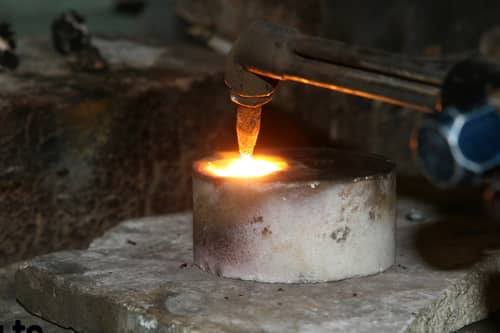The Bureau of Labor Statistics estimates that we’ll see over 14,000 new welders enter the workforce by 2028 and a growth rate of 6%. If you’re interested in becoming part of that wave, check out the information below to learn how long it will take to become a welder.
We’ll also walk you through what kind of requirements welding demands, the current job market, salary expectations and more.

Welding Schools, Certificates and Programs
Welding refers to the process of permanently joining metals through heat or pressure. Professional welders use over 100 different methods to execute their professional goals. Often, you’ll find them working within the manufacturing industry, for specialty trade contractors, in repair and maintenance shops or merchant wholesalers.
A small percentage are even self employed. Of course, getting to that point requires specific welding training and education.
Though it is possible to enter the field without a high school diploma, one is preferred. High school students may want to focus on math, science and shop classes. Welding training can begin as early as this phase so long as there is a vocational program offered at the school.
The AWS certification is a performance based evaluation which requires no prerequisite courses or certifications. The exams are designed to test welders on procedures used in the structural steel, petroleum pipelines, sheet metal and chemical refinery welding industries.
Tests for Certified Welder (CW) are performed at AWS Accredited Testing Facilities located throughout the world. Other certification categories include:
- Certified Welding Inspector
- Certified Associate Welding Inspector
- Senior Certified Welding Inspector
- Certified Welding Educator
- Certified Radiographic Interpreter
- Certified Welding Supervisor
- Certified Welding Sales Representative
- Certified Welding Engineer
- Certified Welder
- Certified Robotic Arc Welding
It is important to note that different facilities will offer different opportunities. The American Petroleum Institute, for instance, offers a welding inspection and metallurgy certificate for those looking for work within the petrochemical industry.
Though those looking to acquire certain skills in areas such as exotic welding or underwater welding are encouraged to pursue welding training programs or industry certifications specific to that goal.
START YOUR WELDING CAREER
Earn your degree in Welding Engineering Technology from NEIT and begin your new career path today!
ASSOCIATE'S DEGREE
BACHELOR'S DEGREE
Welding certificate programs help prepare individuals for these kinds of exams. A welding program may last just a few weeks or take up to six months to complete. A school for welding will cover welding theory and welding basics to arm students with the skills they need to start work upon completion. They will learn how to use welding equipment safely, read blueprints and complete work orders.
They will also review proper protocol and safety procedures for working as a welder.
Related Article – Types of welding processes

Earning an associate degree is another option for individuals to consider. This will take around eighteen months to two years to complete. Remember, most courses review practical application, which requires in-person attendance, though the demand for online learning is increasing. Night classes may also be available.
Apprenticeships also offer amazing opportunities to explore the field and receive on-the-job training, though entering into this kind of arrangement with no formal education can take years to advance.
Of course, these estimates may vary depending on your location and employer preferences.
Welding Licenses
Some states may have license requirements for welders in addition to specific welding certification programs and certification requirements. These will differ region to region.
In New York City, for example, applicants for a welding license must successfully complete the American Welding Society Manual-Shielded Metal Arc Welding Process (SMAW) certification or the New York State Department of Transportation Field Welder Certification Manual-Shielded Metal Arc Welding Process for 3G and 4G.
Check in with your local department of labor and training to know about the specific requirements in your area.
Welding Career Path, Salary, and Opportunities for Growth

Pipe welders remain the highest paid position through the welding industry. These individuals can obtain welding training from a variety of education institutions, including vocational schools and community colleges.
The title “journeyman pipe welder” is given to those who have completed training or an apprenticeship to become fully skilled in the art of pipe welding. Some states require you earn journeyman status before you can begin work as a contractor or offer services to the public. The title is also favored by employers and tends to attract more job opportunities.
Related Article – How to become a pipefitter
Jump-Start Your Career as a Welder at the New England Institute of Technology
The New England Institute of Technology is the best welding school in USA and has amazing on campus opportunities for individuals looking to get hands-on training and educational experience in welding.
START YOUR WELDING CAREER
Earn your degree in Welding Engineering Technology from NEIT and begin your new career path today!
ASSOCIATE'S DEGREE
BACHELOR'S DEGREE
Our Associate’s Degree in Welding Engineering Technology introduces welding and pipefitting skills as well as computer-aided design and drafting (CADD), building design, reading blueprints and other classroom theory and best practices. The program will take place in both an academic and laboratory environment.
The program provides intensive training in oxy-acetylene, air carbon arc cutting, brazing, SMAW, GMAW, FCAW, and GTAW. Students will also take courses in industrial OSHA safety procedures and policy, metallurgy, structural design, nondestructive testing, and precision measurement. Students also prepare for future certifications through simulated welder qualification tests.
Graduates of the Welding Engineering Technology program will be prepared for several types of industry positions, including welding engineering technician, production welder, industrial engineering technician, quality control engineering technician, CADD designer, CADD technician, welding industry salesperson, and materials testing technician.
For more information on our program offerings, contact our admission office today! You can also call 800-736-7344 or fill out this form to make an appointment to meet with an admissions officer.

